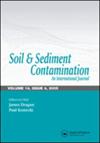铬铁矿加工渣对混凝土结构的影响
IF 1.5
4区 环境科学与生态学
Q4 ENVIRONMENTAL SCIENCES
引用次数: 3
摘要
在20世纪60年代,新泽西州科尔尼地区的许多工业和商业建筑都建在当地生产的铬铁矿加工渣(COPR)上或附近。这种具有砂质/粉质土壤特性的残留物被用作填充物,以恢复当地的沼泽地面条件,当地称为“草地”。通常,充填层厚度在4到10英尺之间,含有不同数量的六价和三价铬。有人声称铬通过各种机制对结构造成破坏。作者通过对文献的研究和回顾,对建造在COPR上或附近的100多个结构的实地调查,涉及暴露于COPR的混凝土的实地研究以及实验室研究,考虑了这些指控。本文对调查研究的结果进行了讨论。研究发现,现有的建筑物和桥梁结构的破坏与破坏的类型和大小没有什么不同。本文章由计算机程序翻译,如有差异,请以英文原文为准。
Effects of chromite ore‐processing residue on concrete structures
In the 1960s, a number of industrial and commercial buildings in the Kearny, New Jersey, area were constructed on or adjacent to locally produced chromite ore‐processing residue (COPR). This residue, which has the properties of a sandy/silty soil, was used as a fill material to reclaim the indigenous swampy ground conditions, known locally as the “Meadowlands”. Generally, the fill stratum is between 4 and 10 ft thick and contains varying amounts of hexavalent and trivalent chromium. It has been alleged that chromium causes damage to structures through various mechanisms. The authors have considered these allegations through research and review of the literature, field investigations of over 100 structures built on or near COPR, field studies involving concrete exposed to COPR, and laboratory studies. The results of the investigations and studies are discussed in this article. It has been found that the existing distress on building and bridge structures is no different from the types and magnitudes of dis...
求助全文
通过发布文献求助,成功后即可免费获取论文全文。
去求助
来源期刊

Soil & Sediment Contamination
环境科学-环境科学
CiteScore
4.20
自引率
10.00%
发文量
53
审稿时长
2.2 months
期刊介绍:
When it comes to assessing and mitigating contaminated soils and sediments, there is no substitute for having the very latest tools, techniques and methodologies at your fingertips to help you deal with these issues efficiently and cost-effectively.
This is just the kind of essential expertise you’ll only find in Soil and Sediment Contamination . This internationally, peer-reviewed publication focuses on soil and sediment contamination from:
-Sludges-
Petroleum-
Petrochemicals-
Chlorinated hydrocarbons-
Pesticides-
Lead and other heavy metals.
Get detailed descriptions of all the latest and most efficient offsite and in situ remediation techniques, strategies for assessing health effects and hazards, and tips for dealing with everyday regulatory and legal issues. With the state-of-the-art tools that Soil and Sediment Contamination provides, you can successfully assess, mitigate, and solve both rural and urban soil contamination problems as efficiently and economically as possible.
 求助内容:
求助内容: 应助结果提醒方式:
应助结果提醒方式:


